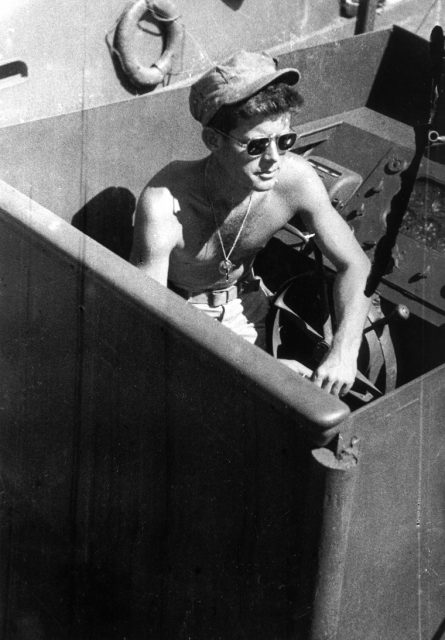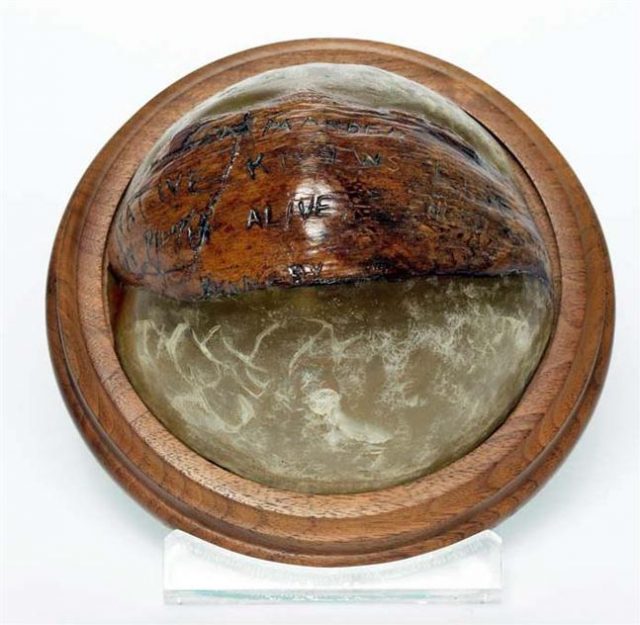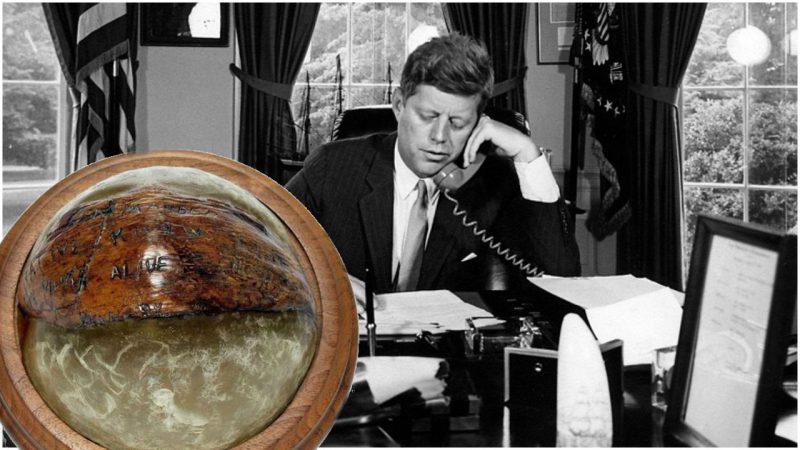During his presidency, John F. Kennedy decorated his desk with a number of items that carried personal meaning. These included model sailing ships, an ornamented whale tooth, and various naval memorabilia.
However, the most unusual and perhaps most significant item was a paperweight made out of an old, battered coconut shell. A faint handwritten inscription on the shell stated: “NAURO ISL… COMMANDER… NATIVE KNOWS POS’IT… HE CAN PILOT… 11 ALIVE…NEED SMALL BOAT …KENNEDY.”
The coconut shell stood on JFK’s desk as a reminder of his almost losing his life in the Pacific in World War II. In 1943, Kennedy was a lieutenant in the U.S. Navy who probably didn’t ever dream about becoming the most powerful man in America. He was in command of PT-109, a small torpedo patrol boat with a crew of 14 men based at Tulagi Island in the Solomon Islands. The boat was tasked with patrolling the waters around the Solomon Islands and scouting the area for Japanese military vessels.

One night in August, PT-109 was intercepted by a 367-foot-long Japanese destroyer named Amagiri. Kennedy’s crew was getting ready to attack the ship, but the gargantuan destroyer was moving fast and was way more agile than they anticipated: It deliberately ran into PT-109 and literally cut the small boat in half. Two men were killed, and the rest of the crew found themselves in the water. Kennedy knew that the Japanese ship might turn around and try to finish off the survivors, so he ordered his men to swim to a nearby island. Although his back was badly damaged from an injury while playing football in college, he managed to tow a badly burned crew member for two hours until reaching the island.
To the misfortune of Kennedy and his crew, the barren island was uninhabited, with no food or water to be found. Kennedy persuaded his crew to swim to another island a couple of miles away that hopefully had some vegetation. The men reached the island after several hours of exhausting swimming; their ordeal was worsened by the constant fear of Japanese patrol ships. They also feared military outposts that could have been hidden on the island. When they arrived, they discovered that the island, then known as Plum Pudding Island and today known as Kennedy Island, was also uninhabited. But it had palm trees.
For the following six days, the crew survived only on coconuts that they found on the palm trees. On the seventh day, they encountered two men in a canoe: the men were natives from a nearby island and, fortunately for Kennedy and his men, they worked with the Coastwatchers, a secret network of agents that informed the Allies of the positions of Japanese military outposts.
They agreed to help the stranded men, so Kennedy etched a message on a coconut shell, and the two islanders brought it to the Allied forces stationed at Tulagi Island.
The two islanders managed to safely avoid a network of Japanese scouts and patrol ships in the waters around the Solomon Islands, and the message found its way to the Allies. After the crew of the ill-fated PT-109 were transported back to safety, Kennedy’s bravery and tactical thinking earned him the Navy and Marine Corps Medal and a Purple Heart.

The story was picked up by a writer, John Hersey, who wrote about it for The New Yorker and Reader’s Digest. Eventually, the episode was turned into a film that was released in June 1963, starring Cliff Robertson as a young Kennedy.
Kennedy remained in contact with the two islanders, whose names were Eroni Kumana and Biuku Gasa, for the rest of his life. Until the tragedy of his assassination in November 1963, he was constantly reminded of his luck in the Pacific by that coconut shell on his desk in the Oval Office.
